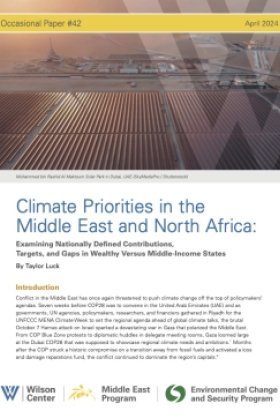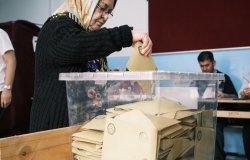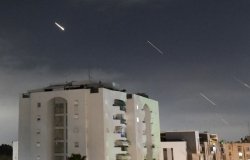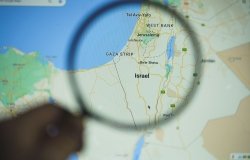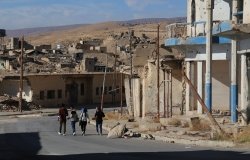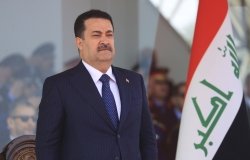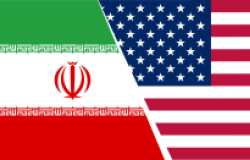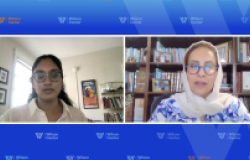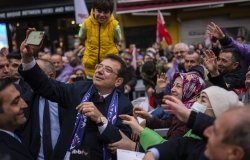Vanguard: Women in the Iranian Election Campaign and Protest
Pari Esfandiari, Founder and President, Eclectic Woman - IranDokht; Fatemeh Haghighatjoo, Former Member of Iranian Parliament and Visiting Scholar, Center for Women in Politics and Public Policy, University of Massachusetts, Boston; Jaleh Lackner-Gohari, Physician and Vice President, innerCHANGE associates international (iCHai); Norma Moruzzi, Associate Professor, Political Science, Gender & Women's Studies, and History, University of Illinois, Chicago; Nayereh Tohidi, Chair and Professor, Gender and Women's Studies Department,California State University, Northridge
Overview
Tohidi gave an overview on women's role in Iranian politics in order to understand their role in the recent election and subsequent protests. She explained that Iran's engagement in gender politics is not a new phenomenon, but rather a culmination of women's quiet involvement in Iranian politics over the last century. Tohidi said that the women most active in the recent uprising tended to be younger, urban-educated, middle class, and of secular orientation, although women of all ages and social strata cohesively participated in the campaigns and post-election protests. She found significance in the diverse background of the movement's icon, Neda Agha-Soltan, the young woman who was shot and killed in the streets of Tehran by the Basij during the protests and who aptly personified the movement's ambitions and composition. According to Tohidi, the significance of female participation in the recent election lies in the non-segregated manner in which it was carried out, with both genders rallying for a common cause and exposing themselves to the same risks. Tohidi also insisted that Iran's newly emerging political culture is distinct from that of the Islamic revolution in that it is non-violent, non-revolutionary, non-gendered, and globalized. Tohidi attributed the growing presence of women in Iranian politics to several domestic factors, including Iran's changing demographics, a growing middle-class, declining birthrates, increase in women's higher education, changes in sexual mores, and high unemployment in the formal sector.
Haghighatjoo described women in Iran as "agents of change." She said that the present "green revolution" is deeply rooted in the role that women played in the 1997 election that brought reformist candidate Khatami to power. She explained that women in Iran have often found themselves on the front line of political change because they have had to bear the brunt of the repressive measures and general disregard for human rights imposed by the Islamic regime and are, therefore, more familiar with the weaknesses in the current political system. However, Haghighatjoo insisted that women's impact on politics extends beyond their voting numbers; women are increasingly holding positions in parliament and other government offices, although Ahmadinejad's incumbency has posed serious challenges to women in the public sphere. Haghighatjoo credits Mousavi's wife, Dr. Zahra Rahnavard, for jumpstarting the "vigorous and zealous" participation of women in the elections and the "green" movement to effect political change. She proceeded to comment on the widespread global turnout for the July 9 demonstrations, which commemorated the tenth anniversary of the "18 Tir" massacre of Tehran University students. She interpreted the mass participation as a symbol of solidarity against the Iranian authorities. Haghighatjoo, like the other panelists, says she is reassured by the unison of female and male voices against both the electoral results and the regime status quo, concluding by saying that, "the Green Veil encompasses the whole country."
Lackner-Gohari gave an activist perspective on the women's movement in Iran and examined the factors behind its broad effect. In order to understand the strength of the women's movement, Lackner-Gohari explored the obstacles that it has overcome. She concluded that the myriad of legal and societal hurdles that exist for women in Iran have energized women and effectively operated as desperate motors to action. Lackner-Gohari also pointed to unconditional family support, an increase in higher education, and fine-tuned communication skills as resources for the women's movement in Iran. According to Lackner-Gohari, the various strategies used by Iranian women to rally their cause are unprecedented. She discussed the role of the global community in the fight for gender justice in Iran, drawing on her experience as an activist based in Vienna, Austria working on Iran's women's issues. Lackner-Gohari emphasized the importance of portraying the face of Iranian women to the world through various acts of solidarity, including mass protests such as the Global Day of Action for Iran scheduled for July 25. However, she concluded by acknowledging that ultimately the fate of Iranian women is in their own hands, reciting the proverb: "No one is going to scratch my back except for the nail on my own finger".
Moruzzi emphasized the nature of the reformist movement in Iran as a broad-based movement cutting across gender, age, and economic status. She described the movement as "entrenched" and "organic" and stressed that it signifies the resurgence of a collective Iranian identity, a phenomenon that first appeared after the election of Khatami. She proceeded to explore what factors have made it possible for women to take a leading role in this movement in the aftermath of the disputed election. Moruzzi asserted that, contrary to the legal measures that relegate women to second-class citizens, material social conditions indicate that Iranian women are healthy, literate, educated, and well-equipped to take part in public life. According to Moruzzi, women have been laying the foundation for political activism in the Islamic Republic for the past decade by building a strong coalition of women's groups, an effort that Moruzzi claimed has taken on new vigor in the past two years. Moruzzi also remarked that the "mixed movement" has given Iranians, particularly Iranian women, a new face in the world's eye. In response to a question regarding US policy on Iran, Moruzzi explained that now is not the time for the US to pursue a policy of engagement with Iran. Although Moruzzi was a strong proponent of US engagement with Iran prior to the June 12 election, she argued that opening talks with Iran now, after the 30 year dry-spell, would only legitimize Ahmadinejad's unstable regime.
Pari Esfandiari discussed her experience reporting on women's issues in Iran during and after the June 12 election. She explained that, as a nonpartisan reporter, her main goal was to portray an accurate picture of the political landscape in Iran, with special attention to the strong presence of women in the election campaigns and protests. She touched on five subjects that she deemed important to consider when reporting on women in Iran: women as emerging political leaders, women as voters, the role of women's coalitions, the role of communication and internet, and the role of art and pop culture. After the post-election crackdown on journalists, Esfandiari said her organization had to "be more creative" in their methods. She also said that after the government tried to suppress Iranian protesters, sometimes violently, IranDokht could no longer remain nonpartisan and became dedicated to exposing the unrest to the outside world and reminding Iranian protestors that they had broad international support. Esfandiari concluded by pointing out that today the symbol of the color green has moved beyond Mousavi's campaign and become the color of an uprising that is "grassroots, organic, colorful, fluid, and persistent" – all feminine characteristics, she pointed out.
Drafted by Nader Mehran and Anna Van Hollen on behalf of the Middle East Program
Hosted By

Middle East Program
The Wilson Center’s Middle East Program serves as a crucial resource for the policymaking community and beyond, providing analyses and research that helps inform US foreign policymaking, stimulates public debate, and expands knowledge about issues in the wider Middle East and North Africa (MENA) region. Read more
Thank you for your interest in this event. Please send any feedback or questions to our Events staff.

